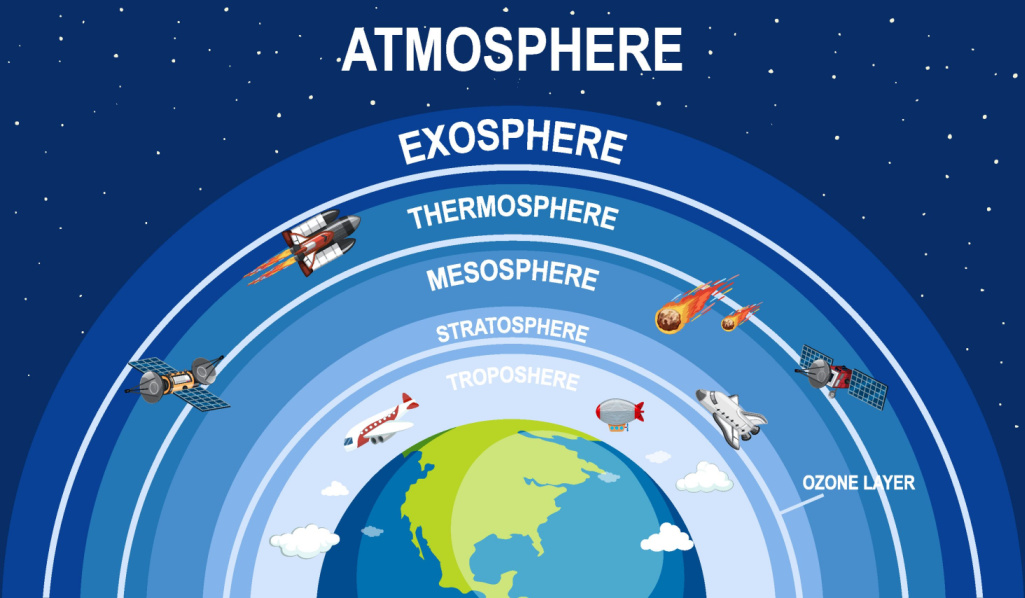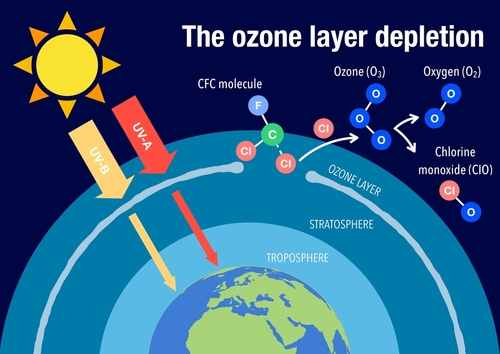October 3, 2022
Which Refrigerant Depletes the Ozone Layer?
The air conditioning unit is a staple piece of equipment in businesses, institutions, and homes around the world. From large central chiller systems to small window units, air conditioners come in many sizes and configurations. However, they all have something in common: they all use refrigerants to transfer heat to the outdoors.
Unfortunately, refrigerants have a checkered past. Many of the chemicals humans have used to cool their living environments have also depleted the ozone layer which is critical for absorbing harmful ultraviolet light from the sun. This ultraviolet light can cause sunburn, skin cancer, premature aging and even blindness. Let’s look at how early refrigerants came to be so harmful and how they continue to impact our planet.
What is the ozone layer?

Ozone (O3) is a naturally occurring gas that is colorless but has a pungent odor. It forms when normal oxygen (O2) molecules absorb ultraviolet rays from the sun. Because of this beneficial reaction, ozone filters much of the sun’s harmful radiation out from hitting the earth’s surface.
The ozone layer is in earth’s stratosphere and occurs between six to thirty miles above the planet’s surface. Actual ozone only makes up a very small portion of the stratosphere: 3 molecules per 10 million air molecules or 0.00006%. While ozone may seem like an insignificant component, it serves a critical role in keeping the sun’s rays tolerable for all living things.
While ozone is created and destroyed naturally, man made chemicals in the air called CFCs inhibit ozone’s ability to form. These chemicals – found in early refrigerants – leave what some refer to as a “hole in the ozone layer.” The more accurate description is a thinning of the ozone layer, it doesn’t create actual holes.
What are refrigerants?
In the early days of air conditioning, your options for refrigerants included ammonia, methyl chloride and sulfur dioxide. Methyl chloride and sulfur dioxide are toxic and were replaced by chlorofluorocarbons (CFCs) in the 1920s. Unfortunately, sulfur dioxide and methyl chloride were used for decades before we understood the drawbacks.
What impact do refrigerants have on the ozone layer?

In the 1970s, scientists discovered that the ozone layer had been depleted in concentration by about 4% per decade. In 1985, the British Antarctic Survey thought their instrumentation was faulty because of how dramatically the ozone levels had dropped. The main cause of the depletion was traced back to the rampant use of man-made substances containing CFCs that had been released into the atmosphere from aerosols and refrigerants. CFCs break down in sunlight to release chlorine and bromine, which destroy ozone molecules.
The polar regions are more susceptible to ozone depletion because of the formation of “polar stratospheric clouds” caused by cold temps in these regions. These clouds provide the ideal conditions for the chemical reactions that break down ozone molecules. Therefore, their ozone levels drop to lower levels than the rest of the globe, creating “holes” or thin spots.
What is the Montreal Protocol?
In September 1987, the Montreal Protocol was introduced to phase-out ozone-depleting refrigerants. This treaty defined the timeline for introducing alternatives that would not affect the ozone layer. A total of 197 states signed it, making it the most successful international treaty to date.
Since the treaty was introduced, refrigerants that contain ozone-depleting substances and, more recently, refrigerants that contribute to global warming are much less popular.
What refrigerants are detrimental?
Many older residential air conditioners used a refrigerant called chlorodifluoromethane (R-22). R-22 refrigerant has a high ozone depleting potential (ODP) and high global warming potential (GWP). The EPA is in the midst of phasing this compound out.
R-410A, a chlorine-free refrigerant was developed to replace it but it also has a high GWP. Chemists continue to seek the “ideal” refrigerant but the likelihood of discovering one soon is low. Hopefully, other alternatives will become more common in the future.
Upgrade to a more efficient AC with safer refrigerants
The EPA suggests that even if your air conditioning unit is only 10 years old, you could still save significantly on a newer model that is 14% or more efficient. If you still have a unit using refrigerants that are destructive to the ozone layer, get in touch with Applewood today. We can help you with a system upgrade!


